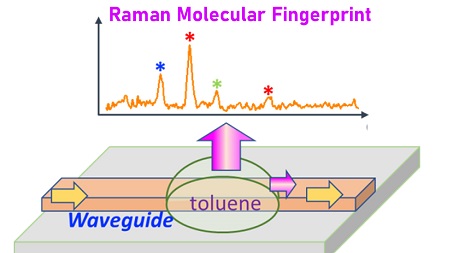Photonics HandbookResearch & Technology
Photonic Chip Gives Raman Spectroscopy a Downsize
COLLEGE STATION, Texas, Sept. 3, 2020 — Researchers at Texas A&M University have invented a technology that can drastically downsize the apparatus used for Raman spectroscopy.
“Raman benchtop setups can be up to a meter long depending on the level of spectroscopic resolution needed,” said Pao-Tai Lin, assistant professor in the Department of Electrical and Computer Engineering and the Department of Materials Science and Engineering. “We have designed a system that can potentially replace these bulky benchtops with a tiny photonic chip that can snugly fit within the tip of a finger.”

Schematic showing the steps for creating the optical waveguide. Courtesy of Texas A&M University College of Engineering.
The chip, Lin said, is also capable of high-throughput, real-time chemical characterization, and despite its size, it is at least 10× more sensitive than conventional benchtop Raman systems.
“Our optical waveguide design provides a novel platform for monitoring the chemical composition of compounds quickly, reliably, and continuously,” Lin said. “Also, these waveguides can be easily manufactured at an industrial scale by leveraging the already existing techniques to make semiconductor devices. This technology, we believe, has a direct benefit for not just pharmaceutical industries but even for other industries like petroleum, where our sensors can be put along underground pipes to monitor the composition of hydrocarbons.”
Traditional benchtop systems contain a variety of optical instruments, including lenses and gratings for manipulating light. Those “free space” optical components take up a great deal of space and serve as an impediment to applications where chemical sensing is required within small spaces and hard-to-reach locations.
Seeking an alternative, Lin and his team turned to waveguides, which are small tube-like conduits capable of transporting light with low loss of energy. The researchers chose aluminum nitride for its low Raman background system and low propensity to interfere with the Raman signal coming from a test sample.
To create the waveguide, the researchers used ultraviolet light to spin a light-sensitive material called NR9 onto a silica surface. Then, using ionized gas molecules, they bombarded and coated aluminum nitride along the pattern formed by the NR9. Finally, the assembly was washed with acetone, leaving behind an aluminum waveguide only tens of microns in diameter.
Lin noted that because their optical waveguides have very fine width, many of them can be loaded onto a single photonic chip. This architecture, he said, is very conducive to the high-throughput, real-time sensing needed for drug development.
The research was published in Analytical Chemistry (www.doi.org/10.1021/acs.analchem.0c00809).
Published: September 2020